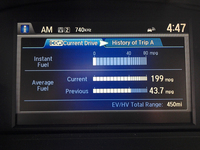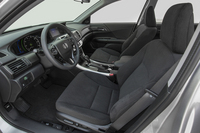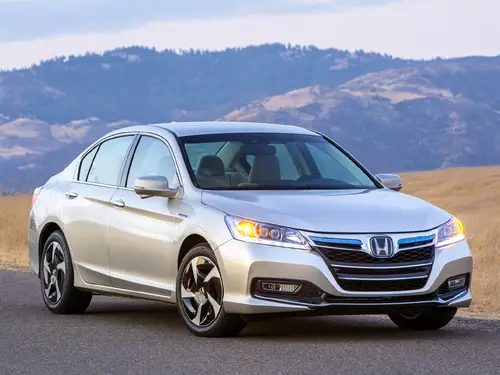2014 Honda Accord Plug-In Hybrid Review by Carey Russ +VIDEO
A very good vehicle for the modern world
DRIVING DOWN THE ROAD WITH CAREY RUSS
• SEE ALSO: Honda Buyers Guide
I drove, and reported on, the Honda Accord Hybrid a few weeks ago. It was quickly followed as a test car by a Honda Accord Plug-In Hybrid. Which made for an excellent opportunity comparison, as follows.
• Read Carey's review of the Accord Hybrid HERE
If you're not a hybrid enthusiast, your first question is likely "What's a plug-in hybrid?" Followed by "What are the advantages and disadvantages?"
A plug-in hybrid vehicle is a hybrid which has a battery pack that can be recharged not only by using its internal combustion engine as a generator and regenerative braking, but also by being plugged directly into the power grid. In all examples that I am aware of, a plug-in hybrid has a larger battery capacity than its regular hybrid relatives. A plug-in hybrid can run in EV mode (Electric Vehicle, under pure battery power) for a greater distance than can a regular hybrid, but less distance than a pure EV. When the battery reserve drops to a certain level, a plug-in hybrid will revert to regular hybrid operation. When the driver makes more demand of the powertrain than can be met by pure electric power, the gasoline engine may be automatically turned on and used, even in EV mode.
 2014 Honda Accord Plug-In Hybrid |
Think of a plug-in hybrid as the step between a regular internal-combustion / electric hybrid and a pure electric vehicle. Like the regular hybrid, it can also charge its battery during operation as it carries its own generator system. Because it operates in EV mode more often and for longer distances than a regular hybrid -- all other variables being equal -- a plug-in will get better fuel economy than a hybrid. Because it has less battery capacity than a pure EV and still uses liquid hydrocarbon fuel (at this point in time) a plug-in won't get the efficiency or low carbon output of a purely electric vehicle -- but when the battery drains to the critical point, infernal combustion comes to the rescue.
 2014 Honda Accord sedan |
The 2014 Honda Accord Plug-In Hybrid made its debut early 2013, before the regular Accord Hybrid. Compared to the regular Hybrid, the Plug-In has distinctive styling, with its own, very different, grille and exterior trim, and offers improved fuel economy because it operates more as an EV -- if the battery is fully charged. The one trim level is fully-equipped, differing from the top-level Hybrid I drove mainly in having "bio-cloth" instead of leather seating. So expect the same comprehensive level of comfort, convenience, connectivity, and safety, including Honda's LaneWatch™ right-side rearview camera.
It weighs about 200 pounds more than the Hybrid and has the same powertrain, so acceleration is slightly less quick. Zero-to-60 in the high rather than low seven-second range. It's still plenty quick enough for everyday use, even in cut-throat traffic, and regenerative braking is very handy descending long grades -- not only does it slow the car in a manner similar to compression braking in the old days, it also recharges the hybrid battery.
Besides the grille, the most notable difference between the Plug-In and regular Hybrid is a small panel on the left front fender, ahead of the driver's-side door. Open the panel, and there is the charging port. Its design and position are now a de facto industry standard, so that most plug-ins and EVs may be charged at public charging stations as well as at home.
The Accord Plug-In can be charged from either 110 or 220 volt outlets. A 110V charger and cord come with the car. My first action after taking delivery of the car was to see if I could recharge it at home. My house has its original wiring, state of the art circa 1943. I had no problem with the Toyota Prius Plug-In, in both prototype and production form, or with the Ford C-Max Plug-In. I tried charging the Chevrolet Volt, and the diagnostics in its charger said "ground fault". No go.
The Accord Plug-In charger looked a lot like the Volt's. And said the same thing. Next step, find a charging station. Since Honda had provided a Charge Point card, check their website. Luck! Multiple stations around town, although most looked like they were really for city and county fleets. One civilian one turned out to have been vandalized; the other worked as advertised: swipe car in front of RFID reader, plug the charging cable in, and 45 minutes later back to full charge. Upon restarting, I pressed the "HV" (Hybrid Vehicle) button to save the battery for later, and drove off in regular hybrid mode.
Later was… I parked at a friend's house near the light-rail station and took the train into the city for an overnight event. When I got back, the black car had been sitting in 100-degree heat for the previous afternoon, and not much cooler the next morning and afternoon. Turn on the air conditioning -- which almost instantly started filling the cabin with cool air -- and drive the ten or so miles home in EV mode.
EV range is listed as 13 miles. The car was down to one bar on the battery gauge when I got home, but I made it, via surface streets and with the air conditioning on. I know better than to try the freeway during commute time. The "199 mpg" display on the information screen was amusing.
In hybrid mode, when the battery was low, the engine was on more often then when the battery was fully or near-fully charged so mileage decreased. No surprise there. I would also presume than anyone intending to buy an Accord Plug-In, or any other PHEV (Plug-in Hybrid Electric Vehicle) or EV would have upgraded their house wiring and maybe even installed an 220-volt charger in their garage. At 220V, full charge time is an hour or less; at 110, it's about three hours.
Why buy a plug-in instead of a regular hybrid or other economical alternative? You're an "early adopter" and want the newest high-tech gadget. Yes, it happens -- alternative power enthusiasts are little different from petrolheads that way. More logically, if your home-to-office commute is within battery range, or close, and charging is available in both locations, you could go for a while between gasoline fixes. And short-distance travel is the worst thing you can do to an internal combustion engine -- if it never really reaches operating temperature, oil will degrade much more quickly than if it is properly heated and can evaporate water (from atmospheric humidity) out. And mechanical components may not reach optimum temperature, increasing wear. So a car with 150,000 well-maintained highway miles is more likely to be in better shape than one of the same age with 5000 short-trip miles.
Is a plug-in worthwhile? The greater cost -- in the case of the Accord, $5000 over the top-level Hybrid or $7500 or more over a regular Accord -- could be somewhat lessened by Federal and State subsidies and tax rebates, with use of commute lanes a further incentive. Honda is not expecting the Accord Plug-In Hybrid to be a major seller. Consider it more a technology demonstrator, almost a proof of concept vehicle. The concept has been proven in the regular Accord Hybrid, which offers pretty much all of the advantages of the plug-in except for the plug-in charging and consequent improvement in mileage for a lower price. In similar driving, I got 38 mpg from the Hybrid and 45 from the Plug-In, not a huge difference. In the end, any decision between the two comes down to logic versus emotion. And both the Accord Plug-In and Hybrid are very good vehicles for the modern world.
SPECIFICATIONS
2014 Honda Accord Plug-In Hybrid
Base Price $ 39,780
Price As Tested $ 40,570
Engine Type DOHC 16-valve aluminum alloy 4-cylinder Atkinson-cycle with i-VTEC variable cam phasing and lift
Engine Size 2.0 liters / 122 cu. in.
Horsepower 141 @ 6200 rpm
Torque (lb-ft) 122 @ 3500-6000 rpm
Battery 6.7 kWh Lithium ion, 41kW/55 hp max output
Electric Traction Motor AC Synchronous permanent magnet
Horsepower 166 @ 3857 - 8000 rpm
Torque (lb-ft) 226 @ 0 - 3857
Total System Horsepower 196
Transmission "e-CVT" multiple drive modes
Wheelbase / Length 109.3 in. / 193.5 in.
Curb Weight 3799 lbs.
Pounds Per Horsepower 19.4
Fuel Capacity 12.2 gal.
Fuel Requirement 87 octane unleaded regular gasoline
Tires P225/50R17 93V Michelin Green X
Brakes, front/rear vented disc / solid disc, ABS and regenerative braking standard
Suspension, front/rear independent MacPherson strut / independent multilink
Drivetrain transverse front engine and motor, front-wheel drive
PERFORMANCE
EPA Fuel Economy - miles per gallon
EPA gas overall / EV equivalent / observed
46 / 115 / 45
0 to 60 mph 7.7 sec
OPTIONS AND CHARGES
Destination Charge $ 790



